This ricotta pesto pasta is creamy and fresh! It has a no-cook sauce that is bursting with rich ricotta flavor, fresh basil pesto, and bright lemon zest. Ready in under 30 minutes, it's perfect for busy weeknight dinners or whenever you want an easy and quick meal!
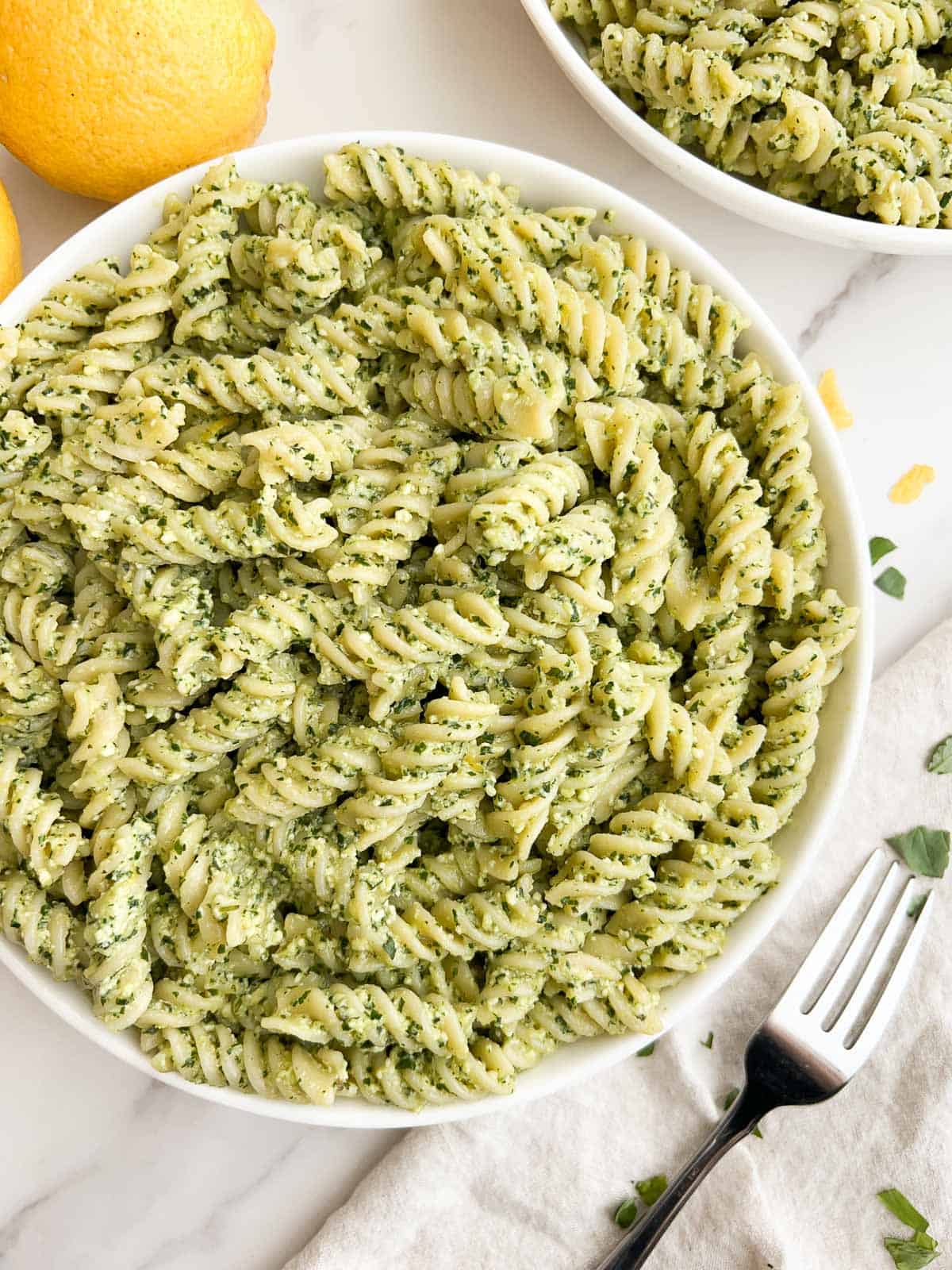
Save This Recipe! 💌
My Italian family is from Genoa, the home of all things pesto. It's no wonder that pesto is an important staple in my kitchen! It's in our weekly dinner rotation not only because of tradition, but also because it's an easy, no cook sauce that can be enjoyed year round.
Having pesto regularly, I'm always looking for ways to get creative. One day, I had leftover ricotta from making my chocolate ricotta cake. I tried mixing it into pesto and I was hooked! It's a simple addition that elevates the dish – adding creaminess and a rich flavor.
If you're looking for more authentic pesto recipes, check out my pasta al pesto. It's inspired by the pesto recipe that has been in my family for generations. I love to serve pesto pasta with a fresh salad, like this arugula and spinach salad or burrata caprese. It goes great with a slice of Ligurian focaccia, a delicious bread from the same region of Italy as pesto. If you would like to add a protein, this bright chicken limone pairs well. A delicious Italian dessert is the perfect end to the meal, with chocolate budino and Italian almond cake being favorites!
Jump to:
Ingredients
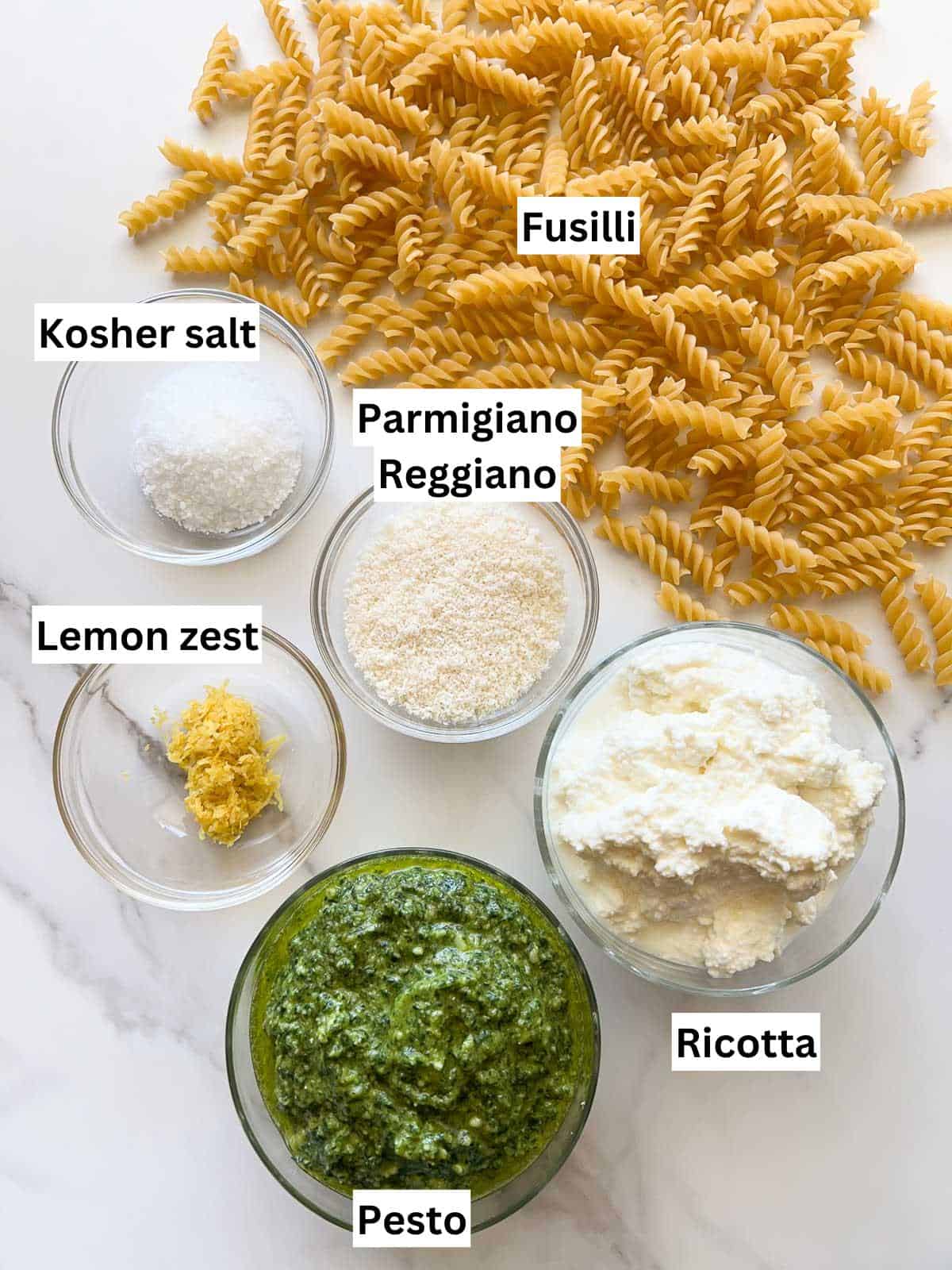
Ingredient Notes:
- Pesto: you can use homemade or store bought pesto. I like to make my own, using my pasta al pesto recipe. It contains fresh basil leaves and pine nuts, making the perfect amount for this recipe. I recommend homemade pesto because it's easy and has the best flavor. It also avoids artificial ingredients and additives that can be found in store bought versions.
- Ricotta: this recipe uses whole milk ricotta with the excess liquid drained. Ricotta is a traditional Italian cheese that is made from the whey of sheep or cow's milk. The choice of ricotta will depend on the flavors you prefer. Ricotta with sheep's milk has a higher fat content that will give your sauce a tangy, complex, and slightly sweet flavor. Ricotta with cow's milk is milder with a neutral, sweet flavor.
- Lemon zest: the bright lemon zest balances the rich ricotta and pesto flavors. To zest a lemon, use a zester or a box grater on the side with the smallest holes. Gently scrape the outer, yellow peel, avoiding the bitter white part underneath.
- Fusilli: choosing the right pasta shape is important! I prefer fusilli, a small corkscrew shaped pasta. The spiral twists capture the thick sauce, ensuring each bite is flavorful. It's a pasta shape I use very often, like in my 6 cheese mac and cheese!
- Parmigiano Reggiano: for the best flavor, I grate the cheese myself, using DOP certified Parmigiano Reggiano. DOP certification is an EU designation that signifies the cheese is made in Italy with strict quality standards. It's made with simple ingredients and aged to develop a sharp, complex nutty flavor. To verify DOP certification, look for the red and yellow DOP seal and the Parmigiano Reggiano consortium logo. You don't have to go somewhere fancy to get it – I often get mine from Costco!
See recipe card for quantities.
Substitutions and Variations
- Use a different pasta shape: you can substitute the fusilli with a pasta shape of your choice. Since ricotta makes the pesto thicker, this sauce pairs best with a shorter pasta that captures and holds the sauce. Rotini, penne, farfalle, and orecchiette are great options.
- Use a different cheese: if you don't have Parmigiano Reggiano available, you can substitute with another cheese. Pecorino Romano or parmesan are good options. If buying pre-grated cheese, I recommend avoiding anti-caking ingredients like cellulose. In my experience, the cheese does not melt as smoothly.
- Add spice: sprinkle a bit of crushed red pepper flakes into the sauce for a spicy kick! It goes great with the bright pesto and creamy ricotta.
Instructions
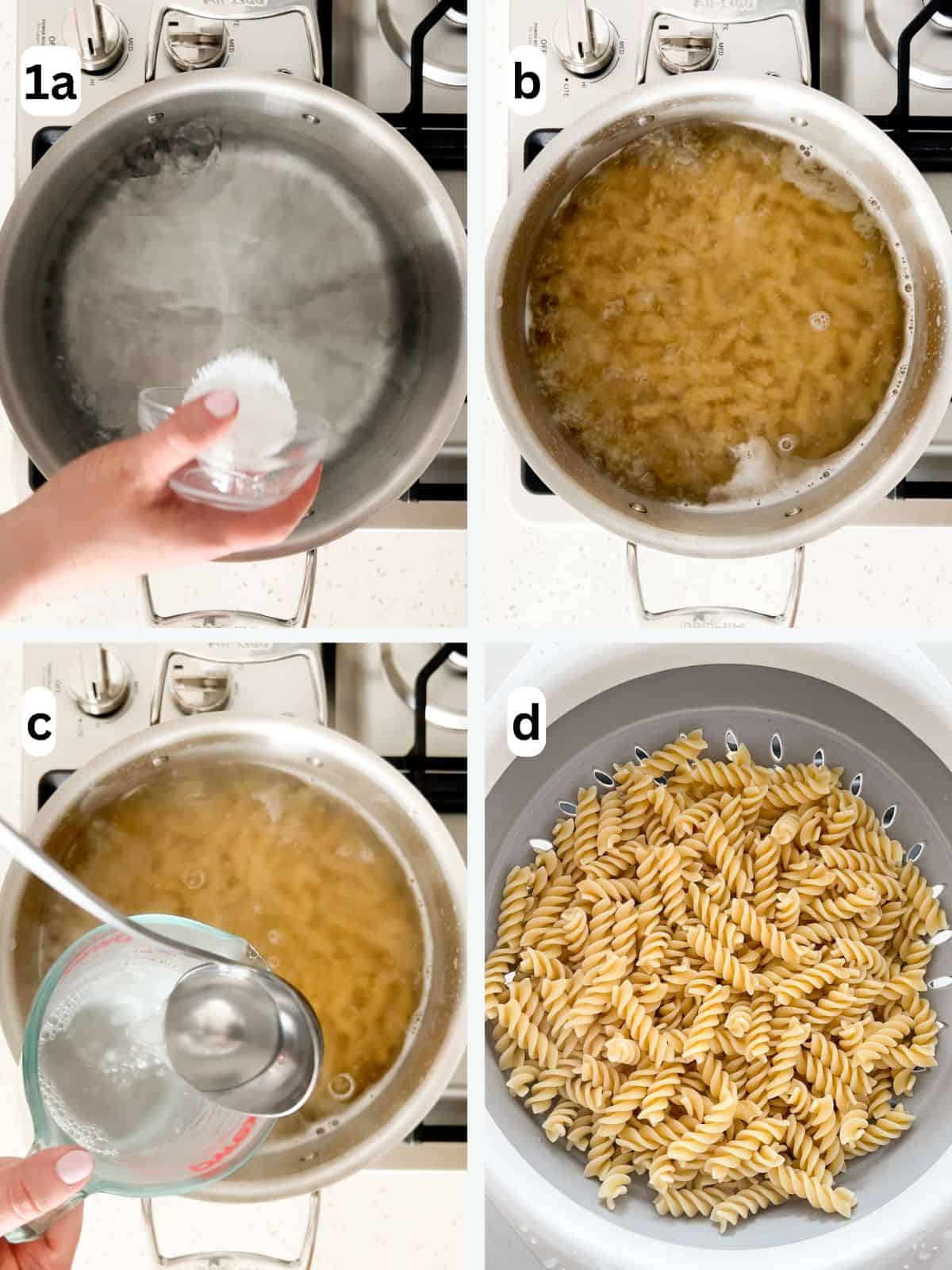
Step 1: bring a large pot of water to a boil and stir in salt (image 1a). Add the fusilli and cook al dente according to the package instructions (image 1b). Just before draining, reserve some pasta water and set aside (image 1c). Then drain the pasta when ready (image 1d).
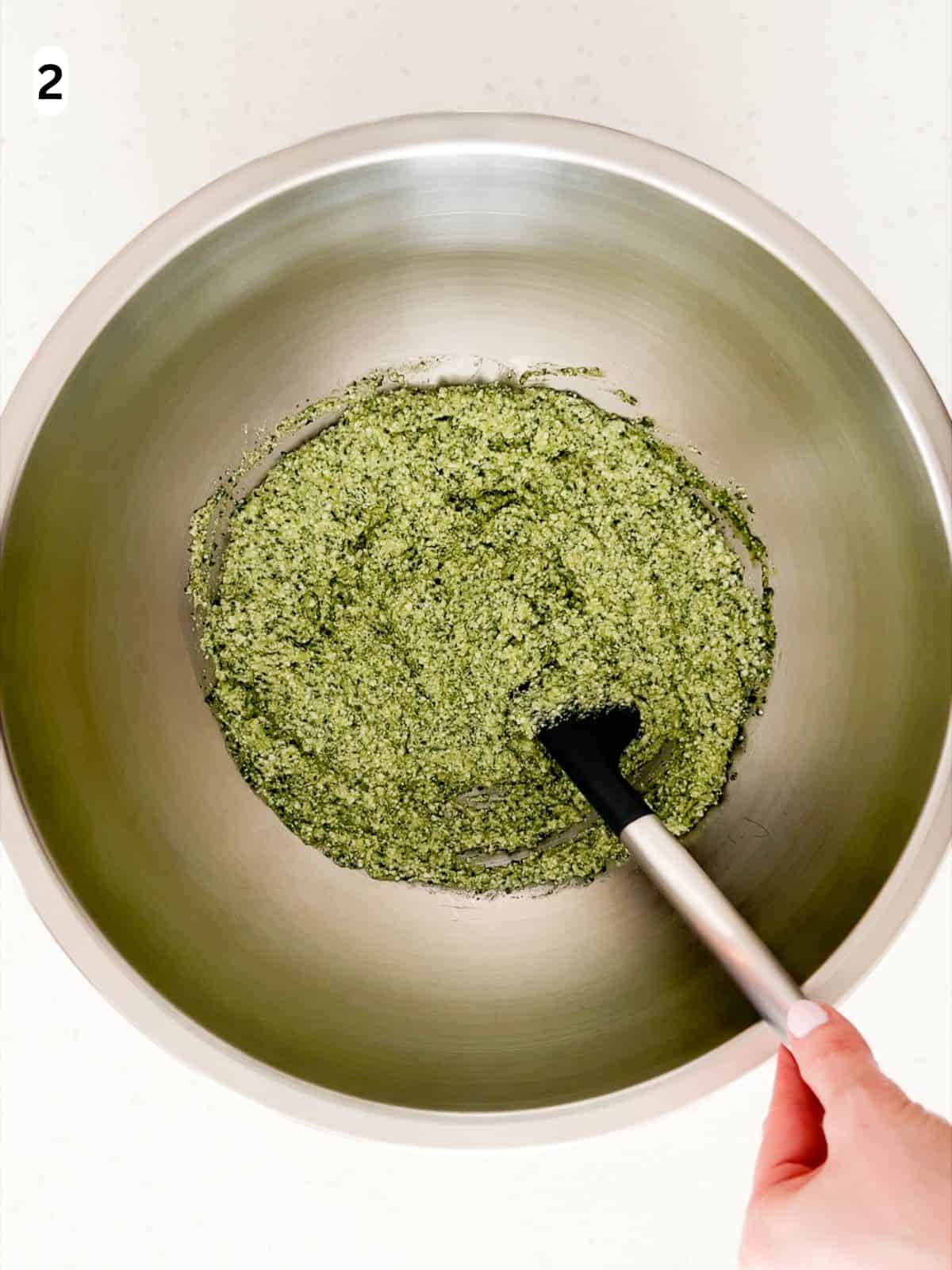
Step 2: while the pasta is cooking, combine the ricotta, pesto, and lemon zest in a large bowl. Stir together until combined (image 2).
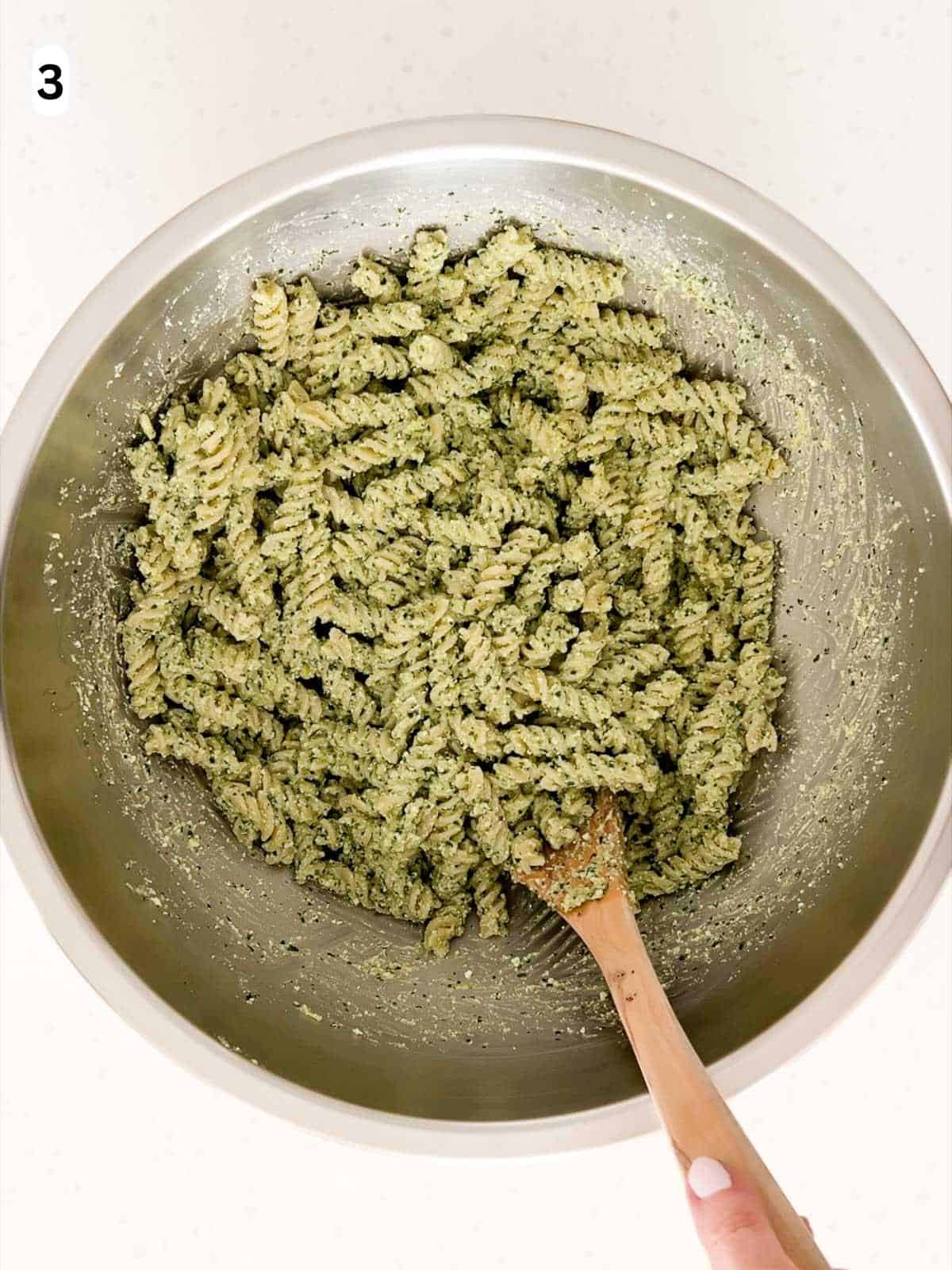
Step 3: add the drained pasta to the bowl with the ricotta pesto. Stir together until the pasta is evenly coated. Slowly add the reserved pasta water as needed to achieve a creamy sauce consistency (image 3).
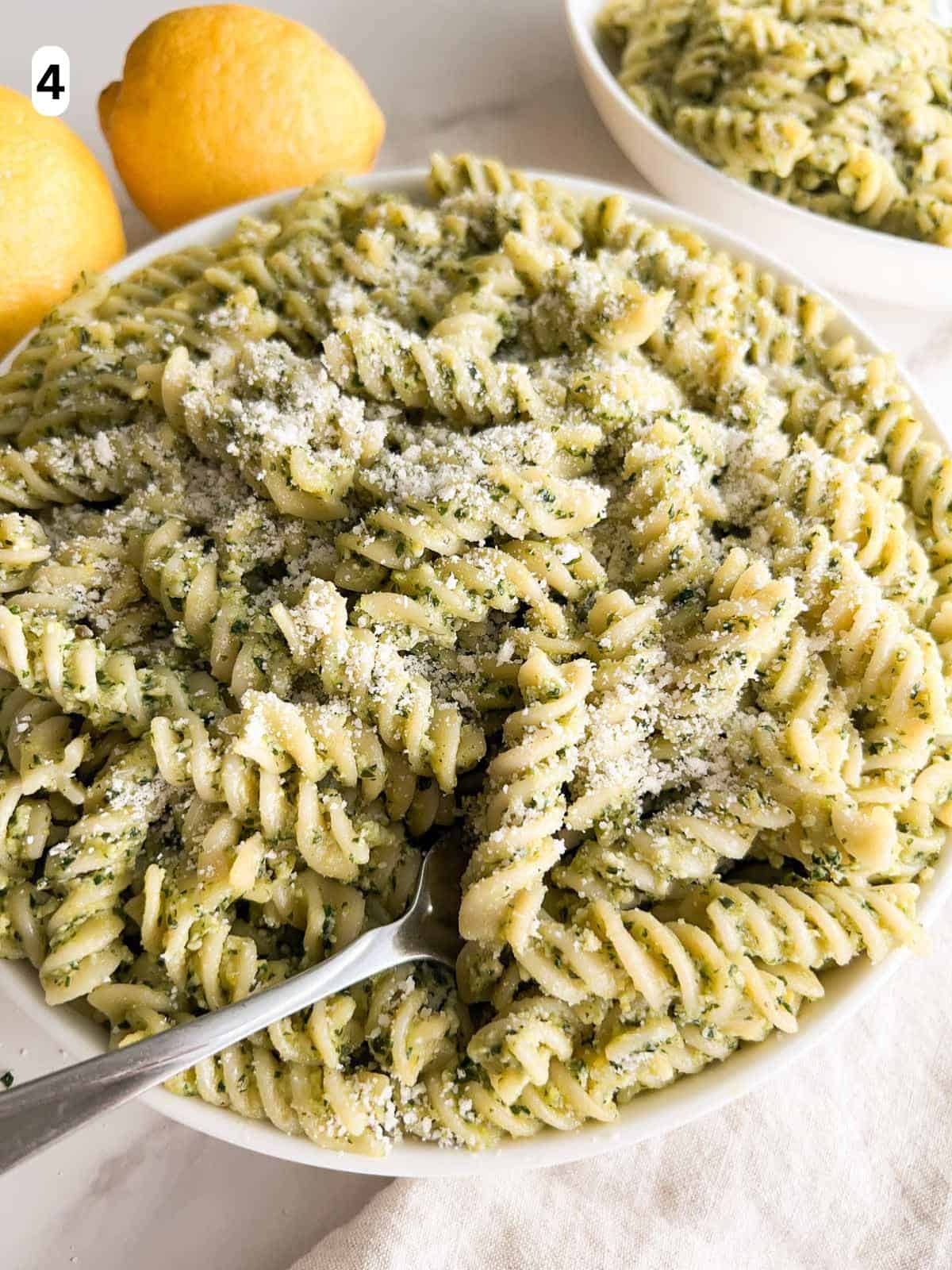
Step 4: stir in the Parmigiano Reggiano until it is melted and evenly distributed. Add salt to taste and pasta water as needed. Garnish with more Parmigiano Reggiano and serve (image 4). Enjoy!
Storage
Leftover pesto ricotta pasta can be stored in an airtight container in the refrigerator for up to 3 days. I like to save a bit of the pasta water to drizzle over the leftovers. I don't recommend freezing this pasta because it can become mushy.
You can reheat the leftovers in a skillet over medium-low heat. Add a bit of pasta water to the skillet to help loosen the sauce and prevent it from drying out. You can also use a microwave in 30 second increments until the pasta reaches 165°F (74°C) throughout.
For more helpful tips on how to store leftovers safely, check out this USDA Leftovers and Food Safety guide.
Expert Tips
- Use a homemade pesto for the best flavor. Making your own pesto is also a great way to avoid unwanted additives and artificial ingredients that may be found in store bought pesto.
- Reserve some pasta water before draining; you'll need it later to adjust the sauce's consistency. The starches in the pasta water bind the sauce to the pasta, making every bite creamy and flavorful.
- Mix in the Parmigiano Reggiano last, after you have combined the pasta with the sauce. This ensures it blends smoothly, creating a creamy sauce without clumping.
FAQ
No, pesto should not be cooked. Pesto contains fresh ingredients like basil, garlic, and olive oil that can lose their vibrant flavors and aromas when heated. Cooking can also cause the basil to become dark and bitter. Pesto is added at the end, after the pasta has finished cooking.
Homemade pesto is easy to make! I recommend using the pesto instructions in my pasta al pesto recipe. It's an authentic Genovese recipe that makes the perfect amount for this pasta. All you need is a handful of simple ingredients like fresh basil leaves, extra virgin olive oil, and pine nuts. Combine it all together in a food processor or blender and you have a delicious and easy pesto. And if you have pine nuts left over, you can use them to make these pignoli cookies for dessert!
Related
For more delicious pasta recipes, check out these favorites:
Pairing
Here are my favorite dishes to serve with ricotta pesto pasta:
Did you make this recipe? Leave a star rating and comment below! Subscribe to my newsletter for new recipes and tips straight to your inbox!
Recipe

Ricotta Pesto Pasta
Save This Recipe! 💌
Ingredients
- 1½ tablespoons kosher salt (plus more to taste)
- 1 pound fusilli (dried)*
- 1 cup ricotta (whole milk; liquid drained)
- 1 cup pesto *
- 2 teaspoons lemon zest (about 1 lemon)*
- ¼ cup Parmigiano Reggiano (grated; plus more for garnish)*
Instructions
- Cook the pasta: bring a large pot of water to a boil. Add the 1½ tablespoons of salt and stir. Then add the fusilli and cook al dente, according to the package instructions. Just before the pasta is done, reserve 1 cup of the pasta water and set aside. Then drain the pasta when ready.
- Make the ricotta pesto sauce: while the pasta is cooking, add the ricotta, pesto, and lemon zest in a large mixing bowl. Stir together until combined.
- Combine the pasta and sauce: add the drained pasta to the large bowl with the ricotta pesto sauce. Stir together until the pasta is evenly coated. Add the reserved pasta water gradually as needed to reach a sauce consistency that is creamy and coats the pasta well.
- Add the Parmigiano Reggiano and serve: stir in the Parmigiano Reggiano until it is melted. Add salt to taste and pasta water as needed. Garnish with more Parmigiano Reggiano, serve immediately, and enjoy!
Video

Notes
- Fusilli: you can substitute with a different pasta shape. Ricotta pesto is thick, pairing well with a shorter pasta that captures the sauce. Penne, rotini, farfalle, or orecchiette are great options.
- Pesto: you can use store bought or homemade. I prefer making my own for the best flavor, using this homemade pesto recipe that makes the perfect amount.
- Lemon zest: you can use a zester or box grater (the side with the smallest holes) to scrape off the outer, yellow peel. Avoid the bitter white part underneath.
- Parmigiano Reggiano: I recommend grating your own for the best flavor and even melting. If you don't have Parmigiano Reggiano on hand, you can substitute with another cheese. Pecorino Romano and parmesan are great options.
- Add spice: add crushed red pepper flakes to the ricotta pesto sauce for a hint of spice. Start slow with ¼ teaspoon, adding more to taste as desired.
- Fresh pasta conversion: you can substitute 1½ pounds of fresh pasta for every pound of dried. Adjust the cooking time accordingly because fresh pasta cooks faster. Go slowly when adding pasta water to the sauce at the end. Since fresh pasta absorbs less water, it can get too liquidy if you add too much.
- Storage: the leftovers can be stored in an airtight container in the refrigerator for up to 3 days. I like to save some pasta water too, for freshening up the sauce. I don't recommend freezing because the pasta can become mushy.
- Reheating: leftovers can be reheated in a skillet over medium-low heat. Add a bit of pasta water to the skillet to loosen the sauce and prevent it from drying out. You can also use a microwave in 30 second increments. Leftovers should be reheated to 165°F (74°C) throughout.
Nutrition
The provided nutrition and storage information is estimated. Accuracy is not guaranteed.
See our Disclaimer for more information.

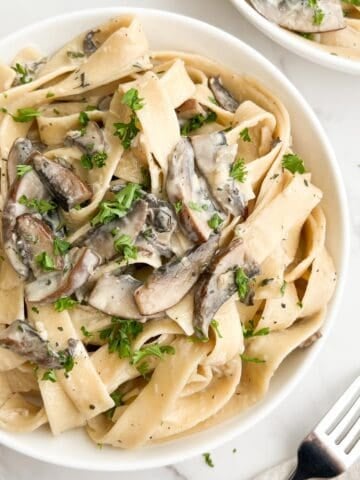
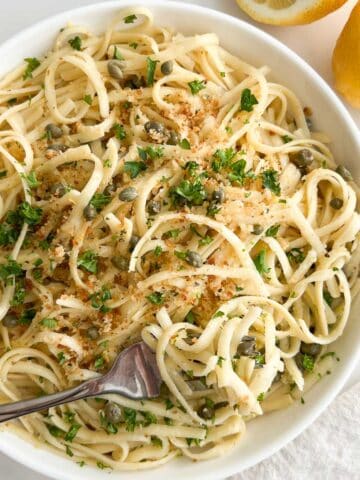
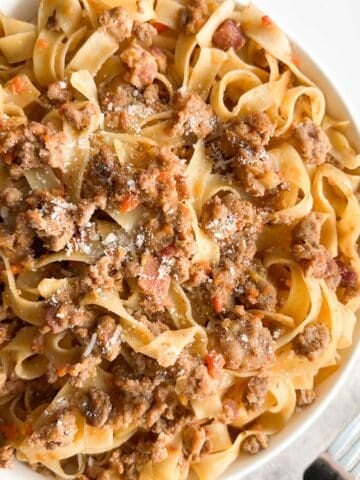
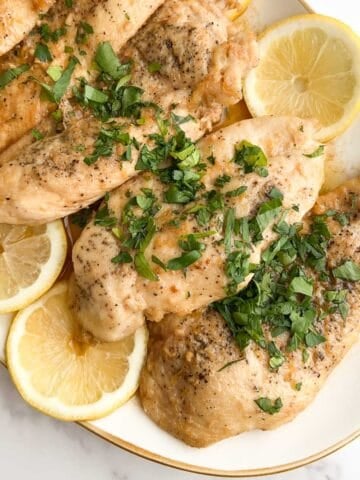
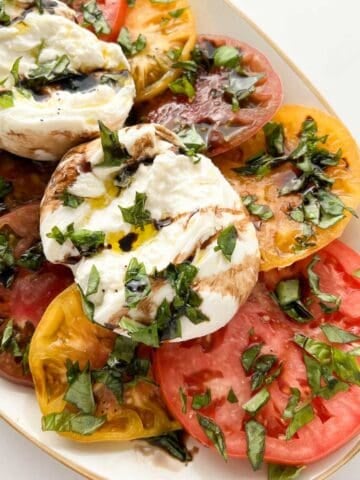
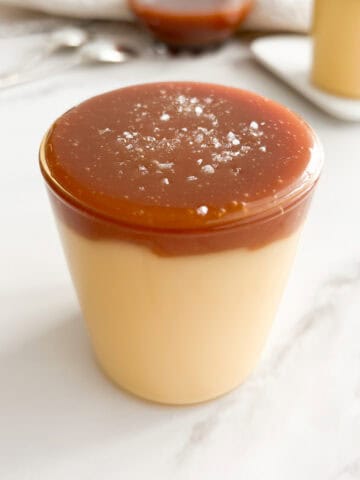
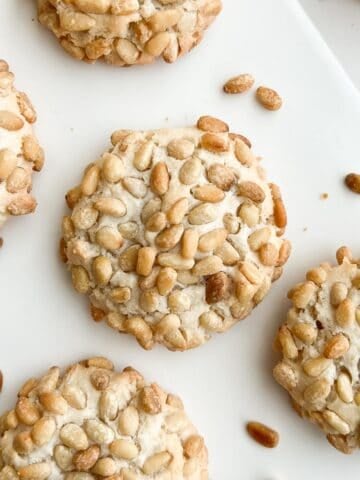
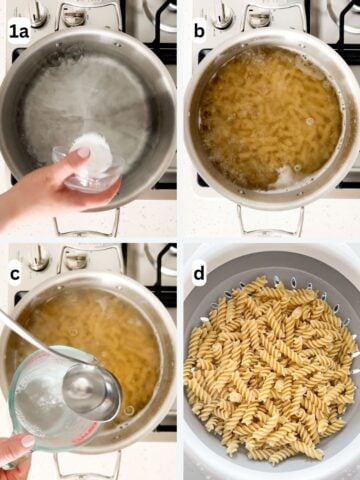
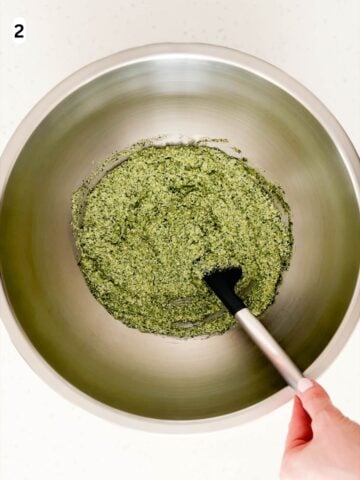
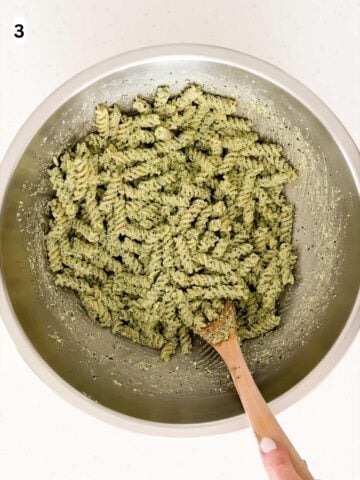
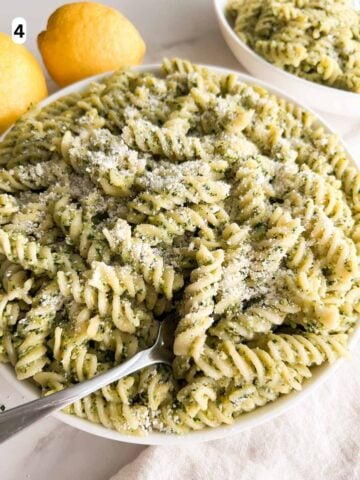
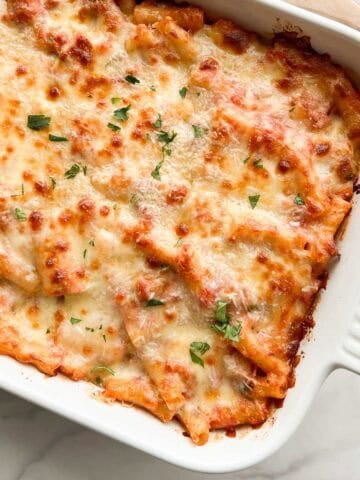
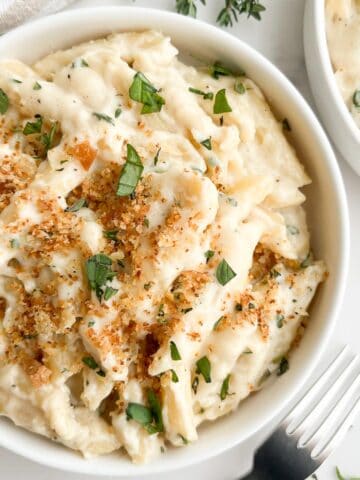
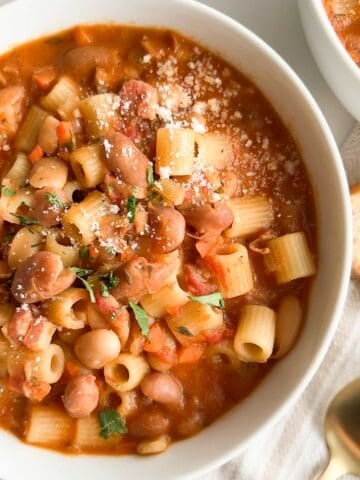
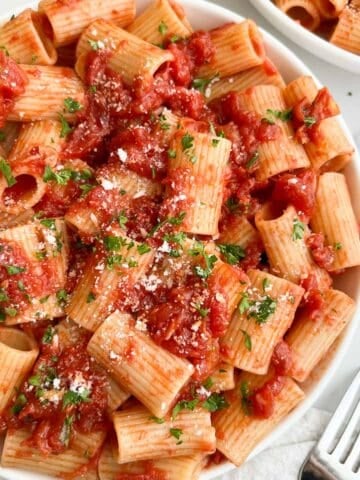
BC Gordon says
We were super impressed with this recipe. Whenever we've made Pesto Pasta in the past it would stick to the pan. Not this time!! We used a jar of pesto this time around due to the season, but we will be making our own this summer and making this again. Everyone in the family loved it, and it was very easy to make!
For anyone who is gluten free (as we are), this recipe works great with gluten free pasta noodles too!
Maria D'Errico says
Thank you so much for leaving a review! Happy to hear your family loved this pasta!
Maria D'Errico says
I hope you enjoy my recipe as much as I did creating it for you.
I love this pasta because it's easy, fresh, and full of flavor. I'd love to hear what you think about it!